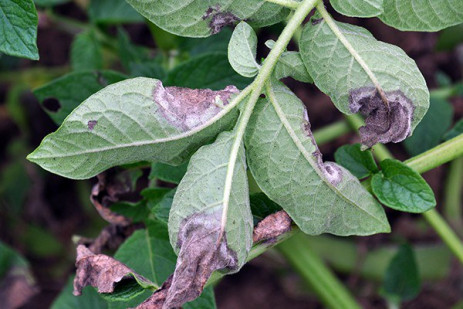Sep 3, 2020Disease concerns surface in Pennsylvania vegetable crops
Late last week, late blight was confirmed in Chautauqua County, New York, on tomatoes and potatoes. Late blight is characterized by irregularly shaped lesions that are initially water-soaked and pale green before turning gray-brown.
Under humid conditions, the lesions on the underside of the leaves will sporulate, giving them a fuzzy white appearance. The lesions will tend to develop on the upper to the middle part of the plant canopy as opposed to early blight or Septoria leaf spot (tomato only) that start on the lower leaves and move upwards, often defoliating the plant if left unmanaged.
Early blight lesions have more well-defined margins and are more circular with tight concentric rings and may be surrounded by yellowing leaf tissue. Fungicide programs that include protectants like mancozeb or chlorothalonil will also help protect against late blight. Many of the recommended products for downy mildew on cucurbit crops are also recommended for late blight on tomato and potato, including Orondis Opti, Ranman, Previcur Flex, etc.
A complete list of recommended fungicides can be found in the 2020-21 Mid-Atlantic Commercial Vegetable Production Recommendations . If you are done with harvest and in a county close to the confirmed report, consider disking under the crop or burning it down with an herbicide, so the field does not unknowingly become a source of inoculum since you are no longer actively scouting. Keep in mind that late blight can also develop in late-season tomato high tunnels. Heavy dew and high humidity can provide enough moisture for disease development. If you suspect late blight on your farm, please let me know either by email at [email protected], by phone at 814-865-7328, or contact your local Extension Office.
Downy mildew on cucumber is widespread across Pennsylvania with one report on butternut squash in Blair Co. Regular scouting remains critical. It is recommended that targeted downy mildew specific fungicides be used on all cucurbit crops, including pumpkin, especially if still several weeks away from harvest and conditions are favorable for disease. Almost all of Pennsylvania has been at moderate to high risk over the past several days. Although downy mildew does not directly affect the fruit, it can quickly defoliate the plants under favorable conditions leaving the fruit subject to sunburn or not fully ripen. Make sure to rotate FRAC codes to minimize the potential development of fungicide resistance. Forecast maps are updated three days a week on Monday, Wednesday, and Friday at the Cucurbit Downy Mildew Forecast Homepage. If you suspect that you may have downy mildew, please let me know by email at [email protected] or by phone at 814-865-7328 or contact your local Extension Office.
As pumpkin harvest begins, there have been several reports of pumpkin fruit rots, which can be caused by several bacterial and fungal diseases. Some growers are seeing small circular whitish lesions on the pumpkin fruit. Depending on the cultivar, they can be surrounded by a dark margin or sometimes a more orangish-yellow to tan margin if the cultivar has a white rind. These are likely the result of bacterial leaf spot caused by Xanthomonas cucurbitae or angular leaf spot caused by Pseudomonas syringae pv. lachrymans, which infected the pumpkins earlier in the growing season. Both are foliar diseases, and the fruit become infected when the bacteria are splash dispersed from the leaves onto the fruit or transferred during passing equipment or people. The bacteria will colonize the lenticels on the fruit surface and, under favorable conditions, multiply and lead to the development of visible symptoms. The lesions can expand, and exudates can ooze from the lesions and dry outside the fruit.
Bacterial spot symptoms on pumpkin fruit. Photo: PA Veg Grower in Bucks Co.
Secondary organisms can also infect and lead to soft rot. Both pathogens are thought to be seedborne, but the impact on disease development is not well understood. Efforts are being made at several universities to better understand the epidemiology of these bacterial diseases and identify a potential seed treatment protocol since cucurbit seed is too sensitive to hot water treatment. A 2-year minimum crop rotation is recommended to allow the crop residue to decompose thoroughly. Applications of copper tank-mixed with mancozeb beginning at fruit set through expansion will help reduce fruit symptoms. However, thorough coverage of the leaves and fruit is necessary. Several university research trials have also demonstrated a reduction in fruit symptoms with the application of Actigard, a plant defense inducing product, in addition to copper prior to disease onset.
Pythium fruit rot on immature pumpkin fruit. Photo: John Esslinger/Penn State
Fruit rots can also be caused by Phytophthora blight, Plectosporium blight, black rot (fruit rot phase of Gummy stem blight), Fusarium rot, Pythium rot, and Sclerotinia rot, among others. For many of these diseases, direct contact between the soil and the fruit is the primary infection site, and complete fungicide coverage is nearly impossible after canopy closure.
Growing pumpkins in a reduced tillage system or having a mulch barrier between the fruit and soil can reduce losses from fruit rots caused by soilborne pathogens. Maintain a 3+ year crop rotation out of pumpkin, and in some cases, rotations with grain crops are recommended due to wide host ranges (e.g., Sclerotinia rot). Managing foliar symptoms will also help reduce losses to fruit rots. Harvest mature fruit as soon as possible to avoid “storing” them in the field. Store fruit in a cool, shaded, and dry location. In general, post-harvest fruit washing is not recommended. The infection occurred in the field, so washing it will not eliminate those pathogens and may spread the pathogens making potential losses worse.
Sclerotinia fruit rot on pumpkin. Photo: John Esslinger/Penn State
– Beth K. Gugino, Penn State University
Photo at top: Whitish sporulation characteristic of late blight on the bottom of potato leaves. Photo: Beth Gugino/Penn State


















